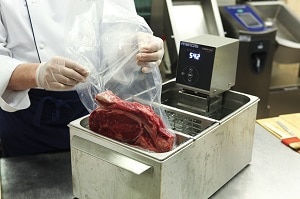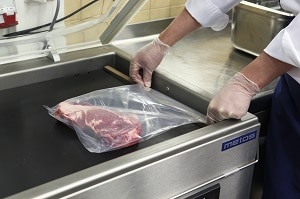
‘Sous vide’ has become a bit of a buzz term in the culinary realm. Pronounced ‘soo-veed’, this is a French term that means ‘under vacuum’. Although it has now reached the giddy heights of fame in today’s professional kitchens, chefs have been using this technique to cook meat, fish and vegetables for many decades. Sous vide relies on precise low temperatures and long cooking in a vacuum pack, in a water or steam bath, to produce ingredients that are perfectly cooked evenly throughout.
HISTORY OF SOUS VIDE
A modern technique it may appear to be, but the earliest pioneer of fundamental sous vide techniques was 18th Century physicist and inventor Sir Benjamin Thompson, Count Rumford. Referenced in the Encyclopedia Britannica as the man whose investigations into heat began the modern theory that heat is a form of motion. In 1799, Thompson experimented with the theory of cooking wrapped meat at a precise low temperature, which would serve to cook the meat evenly throughout and make it extremely tender.
The scientist’s idea was totally ignored in the culinary world until the 1960s, when American, engineers developed the process of cooking vacuum-packed food under pressure, as a form of preservation. But the sous vide we know today didn’t really catch on as a cooking technique in professional kitchens until the mid-1970s. In part down to George Pralus, a chef at the French three Michelin star Restaurant Troisgras, owned by Pierre and Michel Troisgras. Pralus worked out a way to prevent shrinkage while cooking a full fresh goose liver (foie gras), an expensive ingredient used on the menu. He vacuums packed the liver in plastic to get rid of the air, then cooked it gently in a water bath at a low temperature, resulting in perfectly cooked foie gras, with no loss in weight or volume of this exclusive ingredient.
This achievement gave birth to a new cookery technique, adopted by many chefs since. This writer well remembers learning to cook whole Belgian Endives in orange juice and butter in a vacuum bag, leaving them to luxuriate in a controlled temperature water bath for several hours, until every trace of their intrinsic bitterness disappeared, leaving beautifully tender and flavoursome vegetables to serve as a side dish.
Whilst George Pralus was cooking his goose livers sous vide, another Frenchman was also experimenting with this technique during that time. Bruno Goussault was a food scientist who developed sous vide further with different foods and became the trainer of the technique for many chefs of the era. By this time, sous vide as a seriously high-end cookery method for professional chefs was definitely here to stay.
HOW TO COOK SOUS VIDE
As the sous vide technique developed in professional kitchens, equipment eventually moved on from the rudimentary water baths, to industrial sous vide machines which were way too big and too expensive for home use. This allowed the technique to remain in the realm of only the most innovative chefs and kitchens.
Today, almost any kitchen, even a home kitchen, can invest in small sous vide cooker, which is by far the best way to achieve the right results. High profile chefs have released recipes for the home cook. Here are a few tips to get you going:
● You can buy a vacuum packing machine for home use very reasonably these days. They are not just useful for cooking sous vide, but for packing raw and cooked ingredients for the fridge and freezer. Removing the air preserves the veggies and takes up less storage space than normal freezer bags. Available from around €50 upwards, depending on size.
● If you don’t have a vacuum packer, use good quality zip lock freezer bags for cooking your ingredients sous vide.
● Professional sous vide cooker for home cooking will set you back anywhere from around €120 upwards, depending on brand and quality. Readily available online. An expensive outlay, but really the best way to achieve good results at home.
● If you haven’t got professional sous vide cooker, you can make do with a deep pan for a water bath and an electronic thermometer kit to make sure your temperature is constant. An average temperature for cooking steak sous vide is 56C for medium-rare meat, going up to 65C for Medium Well and 71C for well done. There are sous vide temperature charts available online.
● Place your chosen meat, fish or vegetables in the bag, adding butter, herbs and seasonings of choice. Vacuum pack or use zip lock bags. If you are using these, American dining and home entertaining hostess Doyenne Martha Stewart recommends popping the open bag into the pan of water to let the air out, then locking the bag and clipping it to the side of the pan with a freezer bag clip or clothes peg. This will keep the bag submerged in the water throughout cooking. Bring the water back to the required temperature and start timing.
● Sous Vide is very popular for cooking steak. Most chefs like to sear the steaks after cooking sous vide, to give a crisp brown finish. You need a good heavy-bottomed pan for this. Get it very hot. Remove the steak from the sous vide bag and place it in the hot pan. Add butter and herbs. Brown quickly both sides. Season and serve.
● If you really want to get into sous vide in a big way, invest in a good cookbook like the famous ‘Under Pressure’ by American chefs Thomas Keller and Michael Ruhlman.
Buy Gift Voucher




